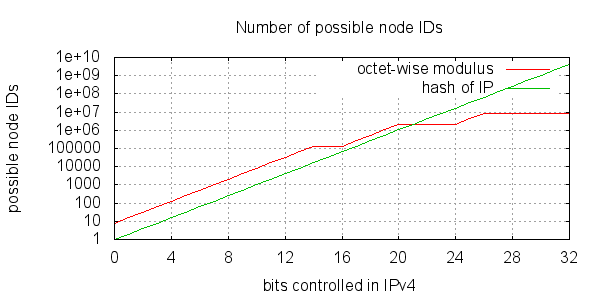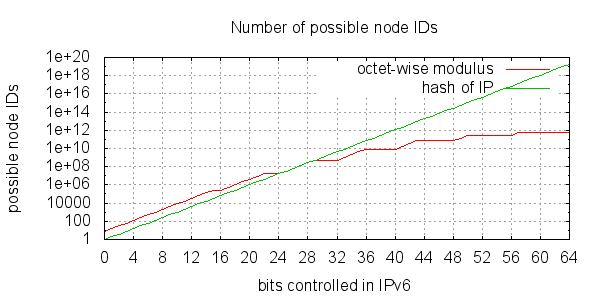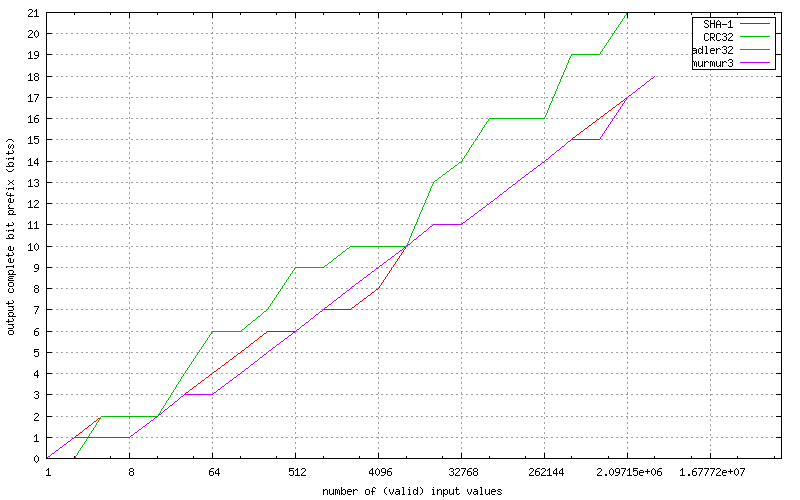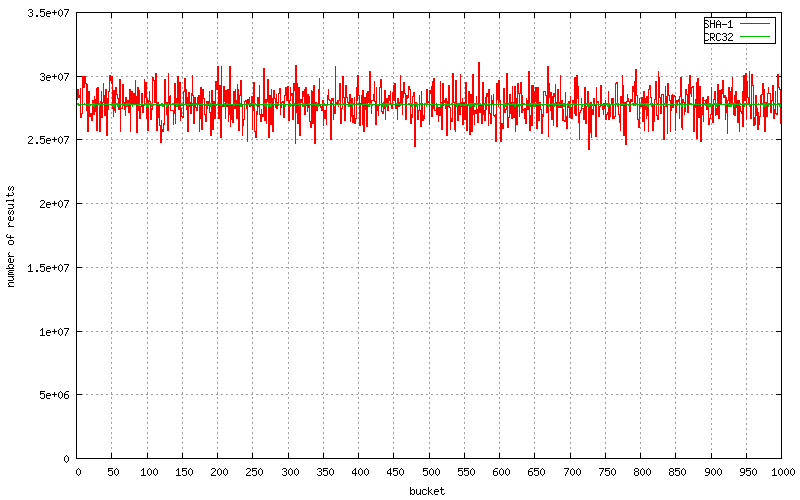| BEP: | 42 |
|---|---|
| Title: | DHT Security extension |
| Version: | 9c5c1dd1b372016e05af84fb34fccac6752ef54a |
| Last-Modified: | Thu Jul 21 10:45:38 2016 -0400 |
| Author: | Arvid Norberg <arvid@bittorrent.com> |
| Status: | Draft |
| Type: | Standards Track |
| Created: | 15-January-2014 |
| Post-History: | 2-July-2015: Clarify enforcement behaviour |
DHT Security Extension
The purpose of this extension is to make it harder to launch a few specific attacks against the BitTorrent DHT and also to make it harder to snoop the network.
Specifically the attack this extension intends to make harder is launching 8 or more DHT nodes with node-IDs selected close to a specific target info-hash, in order to become the main nodes hosting peers for it. Currently this is very easy to do and lets the attacker not only see all the traffic related to this specific info-hash but also block access to it by other peers.
The proposed guard against this is to enforce restrictions on which node-ID a node can choose, based on its external IP address.
Considerations
One straight forward scheme to tie the node ID to an IP would be to hash the IP and force the node ID to share the prefix of that hash. One main drawback of this approach is that an entities control over the DHT key space grows linearly with its control over the IP address space.
In order to successfully launch an attack, you just need to find 8 IPs whose hash will be closest to the target info-hash. Given the current size of the DHT, that is quite likely to be possible by anyone in control of a /8 IP block.
The size of the DHT is approximately 8.4 million nodes. This is estimated by observing that a typical routing table typically has about 20 of its top routing table buckets full. That means the key space is dense enough to contain 8 nodes for every combination of the 20 top bits of node IDs.
2^20 * 8 = 8388608
By controlling that many IP addresses, an attacker could snoop any info-hash. By controlling 8 times that many IP addresses, an attacker could actually take over any info-hash.
With IPv4, snooping would require a /8 IP block, giving access to 16.7 million Ips.
Another problem with hashing the IP is that multiple users behind a NAT are forced to run their DHT nodes on the same node ID.
Node ID restriction
In order to avoid the number node IDs controlled to grow linearly by the number of IPs, as well as allowing more than one node ID per external IP, the node ID can be restricted at each class level of the IP.
Another important property of the restriction put on node IDs is that the distribution of the IDs remain uniform. This is why CRC32C (Castagnoli) was chosen as the hash function.
The expression to calculate a valid ID prefix (from an IPv4 address) is:
crc32c((ip & 0x030f3fff) | (r << 29))
And for an IPv6 address (ip is the high 64 bits of the address):
crc32c((ip & 0x0103070f1f3f7fff) | (r << 61))
r is a random number in the range [0, 7]. The resulting integer, representing the masked IP address is supposed to be big-endian before hashed. The "|" operator means bit-wise OR.
The details of implementing this is to evaluate the expression, store the result in a big endian 64 bit integer and hash those 8 bytes with CRC32C.
The first (most significant) 21 bits of the node ID used in the DHT MUST match the first 21 bits of the resulting hash. The last byte of the hash MUST match the random number (r) used to generate the hash.


Example code code for calculating a valid node ID:
uint8_t* ip; // our external IPv4 or IPv6 address (network byte order)
int num_octets; // the number of octets to consider in ip (4 or 8)
uint8_t node_id[20]; // resulting node ID
uint8_t v4_mask[] = { 0x03, 0x0f, 0x3f, 0xff };
uint8_t v6_mask[] = { 0x01, 0x03, 0x07, 0x0f, 0x1f, 0x3f, 0x7f, 0xff };
uint8_t* mask = num_octets == 4 ? v4_mask : v6_mask;
for (int i = 0; i < num_octets; ++i)
ip[i] &= mask[i];
uint32_t rand = std::rand() & 0xff;
uint8_t r = rand & 0x7;
ip[0] |= r << 5;
uint32_t crc = 0;
crc = crc32c(crc, ip, num_octets);
// only take the top 21 bits from crc
node_id[0] = (crc >> 24) & 0xff;
node_id[1] = (crc >> 16) & 0xff;
node_id[2] = ((crc >> 8) & 0xf8) | (std::rand() & 0x7);
for (int i = 3; i < 19; ++i) node_id[i] = std::rand();
node_id[19] = rand;
test vectors:
IP rand example node ID ============ ===== ========================================== 124.31.75.21 1 5fbfbf f10c5d6a4ec8a88e4c6ab4c28b95eee4 01 21.75.31.124 86 5a3ce9 c14e7a08645677bbd1cfe7d8f956d532 56 65.23.51.170 22 a5d432 20bc8f112a3d426c84764f8c2a1150e6 16 84.124.73.14 65 1b0321 dd1bb1fe518101ceef99462b947a01ff 41 43.213.53.83 90 e56f6c bf5b7c4be0237986d5243b87aa6d5130 5a
The bold parts of the node ID are the important parts. The rest are random numbers. The last bold number of each row has only its most significant bit pulled from the CRC32C function. The lower 3 bits are random.
Bootstrapping
In order to set ones initial node ID, the external IP needs to be known. This is not a trivial problem. With this extension, all DHT responses SHOULD include a top-level field called ip, containing a compact binary representation of the requestor's IP and port. That is big endian IP followed by 2 bytes of big endian port.
The IP portion is the same byte sequence used to verify the node ID.
It is important that the ip field is in the top level dictionary. Nodes that enforce the node-ID will respond with an error message ("y": "e", "e": { ... }), whereas a node that supports this extension but without enforcing it will respond with a normal reply ("y": "r", "r": { ... }).
A DHT node which receives an ip result in a request SHOULD consider restarting its DHT node with a new node ID, taking this IP into account. Since a single node can not be trusted, there should be some mechanism to determine whether or not the node has a correct understanding of its external IP or not. This could be done by voting, or only restart the DHT once at least a certain number of nodes, from separate searches, tells you your node ID is incorrect.
Rationale
The choice of using CRC32C instead of a more traditional cryptographic hash function is justified primarily of these reasons:
- it is a fast function
- produces well distributed results
- there is no need for the hash function to be one-way (the input set is so small that any hash function could be reversed).
- CRC32C (Castagnoli) is supported in hardware by SSE 4.2, which can significantly speed up computation
There are primarily two tests run on SHA-1 and CRC32C to establish the distribution of results. The first one is the number of bits in the output set that contain every possible combination of bits. The CRC32C function has a longer such prefix in its output than SHA-1. This means nodes will still have well uniformly distributed IDs, even when IP addresses in use are not uniformly distributed.
The following graph illustrate a few different hash functions with regard to this property.

This test takes into account IP addresses that are not globally routable, i.e. reserved for local networks, multicast and other things. It also takes into account that some /8 blocks are not in use by end-users and extremely unlikely to ever run a DHT node. This makes the results likely to be very similar to what we would see in the wild.
These results indicate that CRC32C provides the best uniformity in the results in terms of bit prefixes where all possibilities are represented, and that no more than 21 bits should be used from the result. If more than 21 bits were used, there would be certain node IDs that would be impossible to have, which would make routing sub-optimal.
The second test is a sanity test for the uniform distribution property. The target space (32 bit integer) is divided up into 1000 buckets. Every valid IP and r input is run through the algorithm and the result is put in the bucket it falls in. The expectation is that each bucket has roughly an equal number of results falling into it. The following graph shows the resulting histogram, comparing SHA-1 and CRC32C.

The source code for these tests can be found here.
The reason to use CRC32C instead of the CRC32 implemented by zlib is that Intel CPUs have hardware support for the CRC32C calculations. The input being exactly 4 bytes is also deliberate, to make it fit in a single instruction.
Enforcement
Once enforced, responses to get_peers requests whose node ID does not match its external IP should be considered to not contain a token and thus not be eligible as storage target. Implementations should take care that they find the closest set of nodes which return a token and whose IDs matches their IPs before sending a store request to those nodes. In the original DHT specification only announce_peer stores data in the network, but any future extension which stores data in the network SHOULD use the same restriction.
Non-compliant nodes also must not be considered to have sent a valid response when checking the termination condition of a lookup. For example, if a lookup stops sending requests after good responses have been received from the closest 8 peers then non-compliant nodes must not be included in that count.
Any peer on a local network address is exempt from this node ID verification. This includes the following IP blocks:
- 10.0.0.0/8
- reserved for local networks
- 172.16.0.0/12
- reserved for local networks
- 192.168.0.0/16
- reserved for local networks
- 169.254.0.0/16
- reserved for self-assigned IPs
- 127.0.0.0/8
- reserved for loopback
Backwards Compatibility and Transition
During some transition period, this restriction should not be enforced, and peers whose node ID does not match this formula relative to their external IP should not be blocked.
Requests from peers whose node ID does not match their external IP should always be serviced, even after the transition period. The attack this protects from is storing data on an attacker's node, not servicing an attackers request.
Even after the transition period, enforcing nodes MAY also announce to non-compliant nodes as long as they also announce to the closest set of compliant nodes.
Forward Compatibility
If the total size of the DHT grows to the point where the inherent size limit in this proposal is too small, the modulus constants can be updated in a new proposal, and another transition period where both sets of modulus constants are accepted.